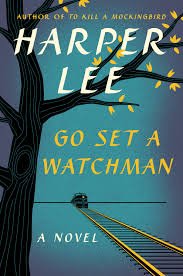Review | Go Set a Watchman by Harper Lee
In as much as it’s possible to make such a statement, To Kill a Mockingbird is a perfect book; the rare modern literary classic that everyone has actually read. (If someone found an earlier, radically different draft of, say, Ulysses, it’s pretty safe to say it wouldn’t be setting records in preorders.) How do you follow that up? The obvious answer isn’t “publish an earlier draft found in mysterious and concerning circumstances over 50 years later” but here we are.
(Mild Spoilers Ahead.)
It is difficult to pin down exactly how to read Go Set a Watchman. This account of a 26 year old Scout visiting her aging father alternates between prequel, sequel and gritty reboot. But treating the book as just an extension of TKAM does a disservice to this fascinating, often despairing work, whose clear eyed look at racism serves the reader a less comfortable lesson than the original: that we are pro-equality up until the point it costs us something.

One of the chief pleasures of GSAW is that it provides a valuable insight into what goes into a classic. Writers dream of editors like Tay Hohoff, who read this draft and saw the seeds of a potential masterpiece, and today’s reader can see the hints and pointers to the novel that it would later become. The writing naturally isn’t as tight as TKAM and the plotting is occasionally wonky, but it is hardly a barren exercise without merit and there are many examples of Lee’s evocative turn of phrase for fans to cherish. If nothing else, the obvious talent on display should end the condescending theory that Truman Capote wrote most of it.
In this darkest timeline Maycomb, Scout bares the most resemblance to her TKAM self. Here she is Jean Louise, the former tomboy whose rebelliousness became more of a problem for society as she grew older. She remains a winning protagonist and our hearts break with every one of her setbacks, for whom this book contains many. (There is an aptness that disappointment is the main theme of a book destined to disappoint many readers.) Interestingly her often embarrassing remembrances of her teenage years suggests that, had things panned out differently, Harper Lee could have become the Southern answer to Judy Blume.
Of course, the big, much publicised deviation is Atticus Finch, who here is revealed to have considerably less progressive views than his TKAM counterpart, and whose differences threaten to drive a wedge between literature’s most beloved father and daughter. But rather than mourn the demolished plaster saint, an open minded reader may see Lee’s insight into a flawed man who will allow his principles to take him only so far, and how far we go to accommodate such men, despite our best intentions (including using descriptors like “flawed” rather than “bigoted”).
This conflict between Atticus and Jean Louise is both the book’s main asset and chief problem. Focusing solely on ideological tensions is compelling, for a while, but it results in an underpowered conclusion which loses focus on the human cost of institutional racism. It’s easy to see why these discussions were eventually replaced by Tom Robinson’s trial in the final version.
Rather than becoming dated, this novel has a startling relevance. Followers of the recent Confederate flag controversy will recognise the convoluted arguments used by several characters to justify discrimination by dressing it up as tradition, and many of the pressures that Scout faces as a young woman can be transported to today with little change (it should be noted that there is a rather triumphant shutdown of mansplaining late in the proceedings). The language changes but the problems remain the same.
For many this book only exists to tarnish a masterpiece, but if To Kill a Mockingbird was the perfect book for 1960, perhaps Go Set a Watchman is the flawed book that 2015 needs.
Featured image via ew.com

